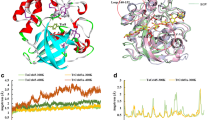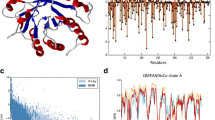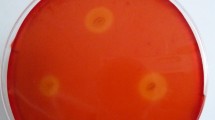Abstract
A hyperthermophilic β-1,4 endoglucanase (EGPh) from the hyperthermophilic archaeon Pyrococcus horikoshii exhibits a strong hydrolyzing activity toward crystalline cellulose. The characteristic features of EGPh are: (1) it appears to have disulfide bonds, which is rare among anaerobic hyperthermophilic archaeon proteins, and (2) it lacks a carbohydrate-binding domain, which is necessary for effective hydrolysis of cellulose. We first examined the relationship between the disulfide bonds and the catalytic activity by analyzing various cysteine mutations. The activities of the mutated enzymes toward carboxy methyl cellulose (CMC) increased without any loss in thermostability. Second, we prepared a fusion enzyme so that the thermostable chitin-binding domain of chitinase from P. furiosus was joined to the C-terminus of EGPh and its variants. These fusion enzymes showed stronger activities than did the wild-type EGPh toward both CMC and crystalline cellulose (Avicel).




Similar content being viewed by others
References
Ando S, Ishida H, Kosugi Y, Ishikawa K (2002) Hyperthermostable endoglucanase from Pyrococcus horikoshii. Appl Environ Microbiol 68:430–433
Bauer MW, Driskill LE, Callen W, Snead MA, Mathur EJ, Kelly RM (1999) An endoglucanase, EglA, from the hyperthermophilic archaeon Pyrococcus furiosus hydrolyzes β-1,4 bonds in mixed-linkage (1->3), (1->4)-β-D-glucans and cellulose. J Bacteriol 181:284–290
Bhat MK, Bhat S (1997) Cellulose degrading enzymes and their potential industrial applications. Biotechnol Adv 15:583–620
Chhabra SR, Kelly RM (2002) Biochemical characterization of Thermotoga maritima endoglucanase Cel74 with and without a carbohydrate binding module (CBM). FEBS Lett 531:375–380
Coutinho PM, Henrissat B (1999) Carbohydrate-active enzymes: an integrated database approach. In: Gilbert HJ, Davies GJ, Svensson B, Henrissat B (eds) Recent advances in carbohydrate engineering. Royal Society of Chemistry, Cambridge, pp 3–12
Ellman GL (1958) A colorimetric method for determining low concentrations of mercaptans. Arch Biochem Biophys 74:443–450
Ellman GL (1959) Tissue sulfhydryl groups. Arch Biochem Biophys 82:70–77
Hiromi K, Takahashi Y, Ono S (1963) Kinetics of hydrolytic reaction catalyzed by crystalline bacterial α-amylase. The influence of temperature. Bull Chem Soc Jpn 36:563–569
Kanaya S, Katsuda C, Kimura S, Nakai T, Kitakuni E, Nakamura H, Katayanagi K, Morikawa K, Ikehara M (1991) Stabilization of Escherichia coli ribonuclease H by introduction of an artificial disulfide bond. J Biol Chem 266:6038–6044
Kashima Y, Mori K, Fukada H, Ishikawa K (2005) Analysis of the function of a hyperthermophilic endoglucanase from Pyrococcus horikoshii that hydrolyzes crystalline cellulose. Extremophiles 9:37–43
Klink TA, Woycechowsky KJ, Taylor KM, Raines RT (2000) Contribution of disulfide bonds to the conformational stability and catalytic activity of ribonuclease A. Eur J Biochem 267:566–572
Matsumura M, Signor G, Matthews BW (1989) Substantial increase of protein stability by multiple disulphide bonds. Nature 342:291–293
Mullis K, Faloona F, Scharf S, Saiki R, Horn G, Erlich H (1986) Specific enzymatic amplification of DNA in vitro: the polymerase chain reaction. Cold Spring Harb Symp Quant Biol 51:263–273
Nakamura T, Ishikawa K, Hagihara Y, Oku T, Nakagawa A, Inoue T, Ataka M, Uegaki K (2005) Crystallization and preliminary X-ray diffraction analysis of the chitin-binding domain of hyperthermophilic chitinase from Pyrococcus furiosus. Acta Crystallogr F 61(5):476–478
Oku T, Ishikawa K (2006) Analysis of the hyperthermophilic chitinase from Pyrococcus furiosus; activity toward crystalline chitin. Biosci Biotechnol Biochem 70(7):1696–1701
Percival Zhang YH, Himmel ME, Mielenz JR (2006) Outlook for cellulase improvement: screening and selection strategies. Biotechnol Adv (in press)
Sakon J, Adney WS, Himmel ME, Thomas SR, Karplus PA (1996) Crystal structure of thermostable family 5 endocellulase E1 from Acidothermus cellulolyticus in complex with cellotetraose. Biochemistry 35:10648–10660
Volkin VB, Klibanov AM (1987) Thermal destruction processes in proteins involving cystine residues. J Biol Chem 262:2945–2950
Wakarchuk WW, Sung WL, Campbell RL, Conningham A, Watson DC, Yaguchi M (1994) Thermostabilization of the Bacillus circulans xylanase by the introduction of disulfide bonds. Protein Eng 7:1379–1386
Wilkinson GN (1961) Statistical estimations in enzyme kinetics. Biochem J 80:324–332
Wood T (1988) Preparation of crystalline, amorphous, and dyed cellulose substrates. In: Wood W, Kellogg S (eds) Methods of enzymology. Biomass part A cellulose and hemicellulose, vol 160. Academic, San Diego, pp 19–25
Acknowledgments
This work was performed as part of the JSPS fellowship program supported by the Japan Society for the Promotion of Science.
Author information
Authors and Affiliations
Corresponding author
Additional information
Communicated by K. Horikoshi.
Rights and permissions
About this article
Cite this article
Kang, HJ., Uegaki, K., Fukada, H. et al. Improvement of the enzymatic activity of the hyperthermophilic cellulase from Pyrococcus horikoshii . Extremophiles 11, 251–256 (2007). https://doi.org/10.1007/s00792-006-0033-2
Received:
Accepted:
Published:
Issue Date:
DOI: https://doi.org/10.1007/s00792-006-0033-2




